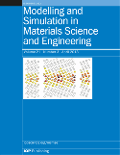
MODELLING AND SIMULATION IN MATERIALS SCIENCE AND ENGINEERING
Scope & Guideline
Advancing the Frontiers of Materials Innovation
Introduction
Aims and Scopes
- Computational Material Science:
The journal emphasizes the use of computational techniques, including molecular dynamics, density functional theory (DFT), and phase-field modeling, to study and predict the properties and behaviors of various materials. - Multiscale Modeling Approaches:
Research published in the journal often involves multiscale modeling, integrating atomic-level simulations with continuum mechanics to provide insights on material behavior across different length scales. - Machine Learning Applications:
A notable focus is placed on the incorporation of machine learning techniques to enhance predictive capabilities and optimize materials design, particularly in the context of high-entropy alloys and complex material systems. - Innovative Simulation Techniques:
The journal features novel simulation methodologies, such as the use of phase-field models, discrete dislocation dynamics, and hybrid atomistic-continuum approaches, to tackle complex material phenomena. - Interfacial and Surface Phenomena:
Significant attention is given to the study of interfacial and surface properties, which are crucial for understanding material performance in applications such as coatings, composites, and nanostructured materials.
Trending and Emerging
- High-Entropy Alloys:
Research on high-entropy alloys is increasingly prevalent, driven by their unique properties and applications in advanced engineering. This trend includes studies on their mechanical performance and microstructural evolution. - Integration of Machine Learning:
The use of machine learning techniques to predict material properties and optimize designs is becoming a dominant theme, showcasing the potential of artificial intelligence in materials science. - Additive Manufacturing Simulations:
There is a growing focus on simulating processes related to additive manufacturing, which includes studies on the solidification dynamics and microstructural evolution during the printing process. - Dynamic Loading and Impact Studies:
Emerging research in the journal highlights the importance of understanding materials under dynamic loading conditions, addressing issues such as shock response and fatigue behavior. - Corrosion and Degradation Mechanisms:
Recent publications increasingly explore corrosion mechanisms and material degradation, particularly in the context of electronic and structural applications, reflecting the need for durability in modern materials.
Declining or Waning
- Traditional Experimental Methods:
There has been a noticeable decrease in papers focusing exclusively on traditional experimental methods, as the field increasingly favors computational and simulation-based approaches for material analysis. - Basic Theoretical Studies:
The journal has seen a reduction in the publication of purely theoretical studies without computational validation, as the integration of computational methods becomes a standard expectation for material science research. - Static Property Analysis:
Research centered on static properties of materials, such as simple tensile testing or basic thermal characterization, appears to be declining in favor of dynamic and time-dependent studies that explore material behavior under various loading conditions.
Similar Journals
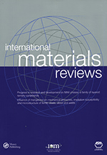
INTERNATIONAL MATERIALS REVIEWS
Elevating Standards in Materials ResearchINTERNATIONAL MATERIALS REVIEWS, published by SAGE Publications Inc, is a leading journal dedicated to the comprehensive analysis of contemporary research in the fields of materials chemistry, mechanical engineering, mechanics of materials, and the study of metals and alloys. With an impressive impact factor and a Q1 ranking across multiple categories such as Materials Chemistry and Mechanical Engineering in 2023, it ranks amongst the top journals for innovative materials research. The journal has a long-standing history since its inception in 1987 and continues to serve as a crucial resource for academics and professionals alike. Although it is not open access, it is renowned for its rigorous peer-review process and its commitment to disseminating high-quality materials science research globally. Researchers, students, and industry professionals benefit greatly from the journal's insightful reviews, both for the advancement of theoretical knowledge and practical applications within the fast-evolving materials field.
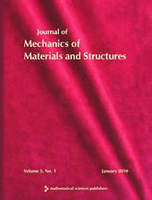
Journal of Mechanics of Materials and Structures
Advancing the Science of Materials and Structures.Journal of Mechanics of Materials and Structures, published by Mathematical Science Publishers, is a distinguished periodical in the field of Applied Mathematics and Mechanics of Materials. With the ISSN 1559-3959, this journal has been a pivotal platform since its inception in 2006, providing insights and advancements in the mechanics of materials and their structural applications. Operating out of the University of California, Berkeley, this journal not only boasts a respectable standing within its categories, ranking Q4 in Applied Mathematics and Q3 in Mechanics of Materials as of 2023, but it also serves a crucial role in fostering academic discourse among researchers, practitioners, and students alike. Although it does not currently offer open access, its contributions to the respective fields are invaluable, underscoring the relevance and importance of continued research in understanding material behavior and structural integrity. Whether investigating theoretical frameworks or engineering applications, the Journal of Mechanics of Materials and Structures remains an essential resource for anyone dedicated to the advancement of the science of materials and structures.

World Journal of Engineering
Pioneering Insights Across Diverse Engineering DisciplinesWorld Journal of Engineering, published by EMERALD GROUP PUBLISHING LTD, stands as a premier platform for disseminating high-quality research across various engineering disciplines. Since its inception in 2014, the journal has built a reputation for its rigorous peer-review process and commitment to advancing knowledge in the fields of Civil and Structural Engineering, Electrical and Electronic Engineering, Geotechnical Engineering, Mechanical Engineering, and Mechanics of Materials. With its categorization in the Q3 quartile across multiple engineering domains and notable Scopus rankings, the journal positions itself as a valuable resource for researchers, professionals, and students seeking to stay abreast of innovations and critical developments in engineering. While the journal currently operates under a subscription model, its comprehensive scope ensures that it remains a vital reference point for contemporary engineering challenges and solutions throughout the United Kingdom and beyond.
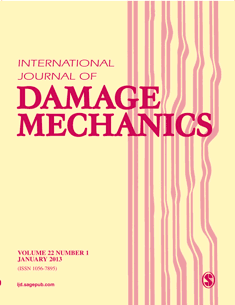
INTERNATIONAL JOURNAL OF DAMAGE MECHANICS
Driving Excellence in Damage Mechanics ResearchINTERNATIONAL JOURNAL OF DAMAGE MECHANICS, published by SAGE PUBLICATIONS LTD, stands as a pivotal peer-reviewed platform contributing to the fields of damage mechanics, computational mechanics, and materials science. With its ISSN 1056-7895 and E-ISSN 1530-7921, this esteemed journal has charted an impressive trajectory since its inception in 1992 and continues to influence the academic community through its high-quality research outputs. Recognized for its excellence, the journal has consistently ranked in the Q1 quartile across various categories including Computational Mechanics and Mechanical Engineering in 2023, reflecting its critical impact in these domains. It has attained an outstanding Scopus rank of #7/89 in Computational Mechanics, positioning it within the top tier of journals in the engineering discipline. The journal's commitment to advancing knowledge is further underscored by its broad scope that attracts innovative research, making it an essential resource for researchers, professionals, and students alike. Though it operates under a traditional subscription model, readers are encouraged to access its wealth of information, which is instrumental in promoting scholarly communication and driving forward the frontiers of damage mechanics.
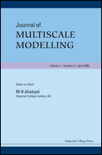
Journal of Multiscale Modelling
Fostering Collaboration in Multiscale ResearchWelcome to the Journal of Multiscale Modelling, a reputable publication dedicated to advancing the fields of Modeling and Simulation and Computer Science Applications. Published by World Scientific Publishing Co Pte Ltd in Singapore, this journal serves as a vital resource for researchers, professionals, and students seeking to explore the intricate relationships between various scales of modeling systems. Since its inception in 2009, the journal has established a pivotal role within the academic community, evidenced by its Q4 ranking in both its respective categories and its interests in contributing to the understanding of complex systems through innovative simulation techniques. With an ISSN of 1756-9737 and an E-ISSN of 1756-9745, the journal encourages submissions that push the boundaries of current knowledge and methodologies. Though currently not open access, articles published in this journal are recognized for their scholarly rigor and innovation, aiming to foster collaboration across disciplines and enhance the practical applications of multiscale modeling techniques in various industries. Join us in exploring the vast potentials of multiscale modeling that lie ahead.

Computational Particle Mechanics
Unleashing the Power of Particle Mechanics for Tomorrow's ChallengesComputational Particle Mechanics, published by SPRINGER INTERNATIONAL PUBLISHING AG, is a leading journal dedicated to advancing knowledge in the interdisciplinary fields of computational mechanics, civil engineering, and fluid dynamics. With an impressive impact factor reflecting its high-quality research publications, this journal maintains a strong presence in the academic community with a Q1 ranking in categories such as Civil and Structural Engineering, Computational Mechanics, and Numerical Analysis as per the latest 2023 evaluations. Researchers and professionals benefit from the journal's commitment to open-access options, promoting wider dissemination of groundbreaking studies. Operating under the Swiss publishing house since 2014, Computational Particle Mechanics aims to foster innovation through the exploration of particle-based methods and simulations, making significant contributions to methodologies within computational mathematics and modeling. As the journal continues to evolve until its converged years end in 2024, it stands as a vital resource for those looking to enhance their expertise in dynamic modeling and simulation techniques.
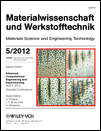
MATERIALWISSENSCHAFT UND WERKSTOFFTECHNIK
Innovating Tomorrow's Materials Today.MATERIALWISSENSCHAFT UND WERKSTOFFTECHNIK, published by WILEY-V C H VERLAG GMBH, is a prominent journal dedicated to the field of materials science and engineering. With its ISSN 0933-5137 and E-ISSN 1521-4052, this journal serves as a vital resource for researchers and professionals engaged in exploring the intricate relationships between the properties of materials and their applications. Established in 1970 and continuing through 2024, the journal has been consistently recognized in various categories, achieving a Q3 ranking in 2023 across Condensed Matter Physics, Materials Science (miscellaneous), Mechanical Engineering, and Mechanics of Materials. Although it does not offer open access, its high-quality peer-reviewed content is fundamental to the advancement of knowledge within its three key areas: novel material development, material characterization, and application of materials in engineering contexts. As a driving force in the scientific community, MATERIALWISSENSCHAFT UND WERKSTOFFTECHNIK continues to cater to the curiosity of aspiring students, seasoned professionals, and researchers alike, facilitating a deeper understanding of the complexities of material technology.

Advances in Materials and Processing Technologies
Advancing Knowledge in Industrial EngineeringAdvances in Materials and Processing Technologies, published by Taylor & Francis Ltd, is a leading academic journal that serves as a dynamic platform for the dissemination of cutting-edge research in the fields of industrial and manufacturing engineering, materials science, and mechanics of materials. With an ISSN of 2374-068X and an E-ISSN of 2374-0698, this journal boasts a commendable impact factor and is recognized for its contribution to advancing knowledge and innovation in processing technologies. The journal is classified within the Q2 category for its fields, indicating its significant standing amongst peers as reflected in its Scopus rankings, where it occupies the 63rd percentile in Industrial and Manufacturing Engineering and the 58th percentile in Mechanics of Materials. As an open-access platform, it aims to foster accessibility to high-quality research outputs and encourages the dissemination of findings from 2015 to 2024. The journal is headquartered in the United Kingdom and plays a pivotal role in supporting researchers, professionals, and students who are committed to the advancement of materials science and processing methodologies.
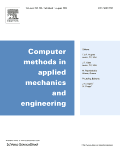
COMPUTER METHODS IN APPLIED MECHANICS AND ENGINEERING
Transforming Theoretical Insights into Practical Applications.COMPUTER METHODS IN APPLIED MECHANICS AND ENGINEERING, published by Elsevier Science SA, is a premier journal that has significantly contributed to the fields of computational mechanics, computer science applications, mechanical engineering, and the mechanics of materials since its inception in 1972. With an ISSN of 0045-7825 and an E-ISSN of 1879-2138, this journal is recognized for its rigorous peer-review process and is consistently ranked in the Q1 quartile across multiple categories, including Computational Mechanics and Mechanical Engineering. Its impressive Scopus rankings place it in the top tiers of its field, with a percentile ranking of 98th in Computational Mechanics. Researchers, professionals, and students will find the journal's comprehensive scope and high-quality articles invaluable for advancing their knowledge and practices at the intersection of engineering and computation. Although not an open-access journal, its impactful contributions to both theoretical and applied research make it an essential resource for anyone involved in these dynamic fields.
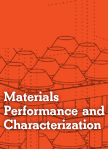
Materials Performance and Characterization
Transforming Materials Science Through Peer-Reviewed InsightsMaterials Performance and Characterization is a distinguished journal published by the American Society for Testing and Materials (ASTM), specializing in the field of materials science. With ISSN 2379-1365 and E-ISSN 2165-3992, this journal serves as a pivotal platform for disseminating innovative research in the areas of metals and alloys, polymers and plastics, ceramics and composites, and mechanics of materials. Established in 2012, it continues to feature peer-reviewed articles that contribute to both theoretical advancements and practical applications, emphasizing the importance of materials performance in various industries. Despite its current Q4 and Q3 rankings across categories as of 2023, the journal is committed to enhancing its influence in the materials science community, fostering engagement among researchers, professionals, and students alike. The journal is essential for anyone seeking to stay at the forefront of materials research and characterization.